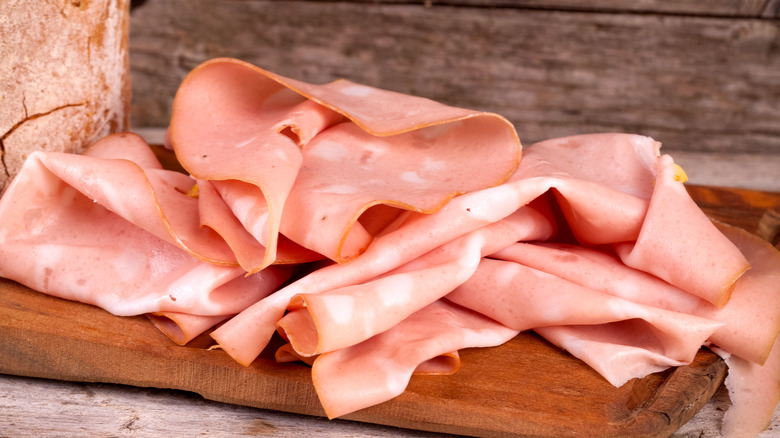Mortadella Vs Bologna: The Mixture Difference To Know
Sliced thin and piled onto good bread, cubed up for snacking, or pan fried for a hot sandwich, cold cuts are delectable. Mortadella and bologna are two common deli meats with a similar look but different make-up. In fact, mortadella is the original, and bologna, or baloney, is the American off-shoot.
Mortadella comes from Bologna in Emilio-Romagna, Italy. It was originally made in the 1600s, and "La Mortadella Bologna IGP" was granted a Protected Geographical Indication by the European Union in 1998. Mortadella is a finely textured sausage made with pork. It must contain at least 15% cubed fat from the neck of the pig; traditionally, it is seasoned with myrtle berries, black pepper, and sometimes pistachios and olives. There are, however, seven different Italian regions where other versions of mortadella can be made.
Bologna more than likely made its way to the United States by way of Italian and German immigrants. In the United States, it came to be pronounced as "baloney" across the board, a mispronunciation of "bologna." This product is also finely textured sausage, but it can be made with a combination of many different cuts of beef, chicken, pork, turkey, and occasionally, organ meat with the addition of salt, water, stock, and seasonings. It is typically associated with lower-quality foods, but there are also artisanal versions. It is required that American bologna be finely ground to the point where no fat is visible and contain no more than 10% water and 30% fat.
What is mortadella?
The name "mortadella" hints at its origins. The term could come from the tool that was used to grind it. Before automation of any kind, the pork in mortadella was pounded fine by hand with a mortar and pestle. Because the process of achieving such a fine and delicate texture was so labor intensive, mortadella was reserved as a delicacy for the elite. Alternatively, before black pepper was available in Europe, mortadella was first seasoned by myrtle berries, which have a peppery, tangy, savory taste. In Italian, myrtle berries are called mirto, which could have evolved linguistically into the word "mortadella."
To make mortadella, high-quality pork is very finely minced. Then, the mince is seasoned, the cubed pork fat is folded in, and the mixture is stuffed into large casings. The mortadella is steamed rather than smoked, then cooled in water, resulting in a very delicate and silky texture. Because of how fine-grained mortadella is, the cubes of fat, spices, and add-ins, such as pistachios and olives, remain firmly set when the whole log is cut.
Traditionally, mortadella is thinly shaved and served simply on a roll or with focaccia. It can be part of a charcuterie board or cut into cubes for an antipasto platter. It can also be blended with a soft cheese, such as ricotta, and used as a spread. It is even sometimes used in pastas as either a filling or sautéed to make a crispy topping.
What is bologna?
Bologna is also a finely textured cold cut, but it's not exclusively made with pork and doesn't have the cubes of fat that mortadella does. This homogeneously textured cased sausage is often simply seasoned, and then baked or smoked. Bologna is springier in texture than mortadella and slightly sweet in taste, similar to a hot dog.
Bologna has a reputation for using low-quality proteins, but there are also regional varieties and artisanal products. Kosher or halal bologna uses only beef and is typically leaner. Lebanon bologna is also made with beef and seasoned with nutmeg and mace. It is smoked and has a drier texture more like summer sausage. It comes from Lebanon County in Pennsylvania and was first made by Dutch immigrants. German bologna is similar to mortadella but is seasoned with garlic.
Ring and rag bologna are named for how they're cased. Ring bologna is more similar in diameter to regular sausage and is packaged in a U-shape, similar to kielbasa. Rag bologna comes from Tennessee and was traditionally sold wrapped in cheesecloth. It can use flour or other grain-based ingredients as fillers in the meat mixture, giving it a softer texture.
A bologna sandwich, served cold and sliced in white bread with mayo, or fried crispy with mustard instead, is classic and delicious. Bologna also makes a great addition to a cold cut spread or pasta salad. Despite its lackluster reputation, bologna comes from greatness and is an American mainstay.



